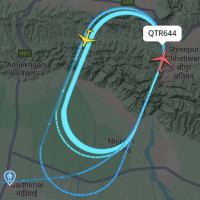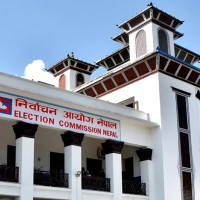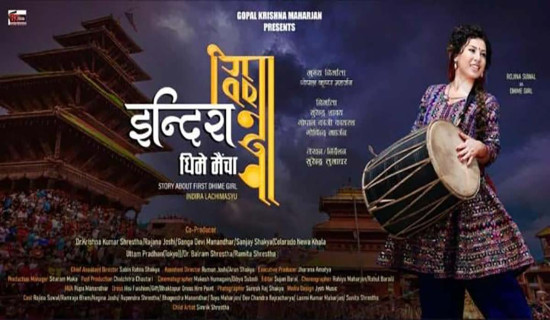- Sunday, 9 November 2025
Citizens Suffer Due To Public Negligence
Recently, four fatalities resulted from electrocution in a vehicular accident in Pathivara, Taplejung district. The accident involved a collision with a low-hanging power line. Nepal Electricity Authority has been accused of being negligent, but they have denied the allegations, stating that the tragedy was caused by lightning from the previous day. This is not the first incident that negligence on the part of the NEA has caused. Each year, many people die from electrocution, often due to NEA's mismanagement. However, NEA consistently denies responsibility and is rarely held liable. Victims have hardly ever been compensated adequately for the physical, mental, and emotional damages they endure.
The accountability and responsibility of public authorities in Nepal remain significantly low. A substantial number of road accidents occur due to potholes and ongoing construction projects that are carried out without proper safety measures, warnings, and cautionary signs. Negligence is not limited to public authorities. Private entities, including schools, hospitals, airlines, hotels, and restaurants, have also been found negligent in discharging their responsibilities to ensure the safety and well-being of individuals under their care. Except in some cases of medical negligence, no other institutions are responsible for adequately compensating the victims for the loss they endure.
The Civil Code promulgated in 2074 B.S. includes a separate chapter relating to the law of torts. It formally codified tort law in Nepal. A tort is a breach of duty that amounts to a civil wrong that causes harm or injury to another person for which there is civil liability, i.e., monetary compensation. Tort law primarily aims to compensate the plaintiff injured by the defendant's conduct. Similarly, it seeks to deter persons from acting in ways that may cause injury to others. Courts typically award unliquidated damages for tort claims, considering the plaintiff's physical, mental, and emotional harm. The basis of tort liability is the well-known Latin maxim 'Ubi jus, ibi remedium', which means that where the law has established a right, there should be a corresponding remedy for its breach.
The evolution of tort law traces back to the development of common law in England. It emerged through judicial interpretation in landmark cases such as Rylands v Fletcher (1868), Donoghue v Stevenson (1932), and Bolton v Stone (1951), among others. Similarly, tort law primarily evolved through court decisions in the United States. Prominent examples include Vosburg v. Putney (1891), Liebeck v. McDonald's (1994), and the Ford Pinto Case.
In India, tort law is not governed by a codified statute but is instead shaped by the principles of English common law. Indian courts have significantly contributed to its development through landmark judgements such as MC Mehta v Union of India (1987) and Bhim Singh v State of Jammu and Kashmir (1986).
As the Nepali legal system is mixed, comprising the features of both civil and common legal systems, we have codified the law relating to torts. Under the Civil Code, the three primary elements of a tort are (i) an act or omission that results in (ii) harm or loss to another person's body, life, property, or other legally protected interests, and (iii) such harm arising from error, negligence, or recklessness. The Code also includes provisions on vicarious liability, liability due to negligence and breach of duty of care, and the basis for determining liability. It recognises both intentional and negligent acts as actionable wrongs under tort law.
Tort lawsuits are confusing because their procedures are not clearly defined. Unlike standard civil lawsuits, they need specific evidence and only cover direct financial losses, not indirect ones. The narrow definition of "loss" as only physical harm ignores other significant damages—financial, emotional, psychological, reputational, and privacy-related—making it hard to get full compensation.
Because the definition of loss is limited to physical damage, unlike the broader range of harms covered by tort law, it's tough to get compensation for all actual losses.
Now, the question arises: can negligence by public authorities be brought under tort liability? A tort is a common law concept developed out of judicial decisions and interpretation by the courts. As evidence examination and liability determination require a special procedure, laying down all tort law provisions is difficult. Usually, it is based on some principles laid down in earlier decisions. There are various instances of public authorities being held accountable for their negligence in common law. In the case of Anns v Merton London Borough Council (1978), the council was sued for negligently inspecting a building, leading to structural defects.
The House of Lords ruled that the council owed a duty of care to homeowners. The council was made liable for negligence, but only in limited circumstances due to policy considerations that gave discretion of inspection to the council. Similarly, in another case of Home Office v Dorset Yacht Co Ltd (1970), Home Office was sued for the damage caused to a yacht by seven boys who had escaped from the borstal – a type of youth detention centre – due to the negligent supervision and failure to exercise a proper duty of care by its officers. It was held that borstal officers owe a duty to exercise reasonable care to prevent individuals from causing harm, especially where there is a clear and foreseeable risk if that duty is breached.
The law of torts is uncodified in India to this day. However, following the common law tradition, the Indian judiciary has made public authorities liable in many instances for their negligence. The case of N. Nagendra Rao & Co. v. State of A.P. (1994) addressed a crucial question regarding the State's vicarious liability for the negligence of its officers while performing statutory functions. The Supreme Court ruled that the state can be held liable for the negligence of its officers, particularly when such negligence results in the deterioration or damage of goods that are not liable to be confiscated. Similarly, in the case of M.P. Electricity Board v. Shila Kumar, the wife of a man who was electrocuted while riding a bicycle—after coming into contact with a live electric wire lying on the road—filed a compensation claim against the M.P. Electricity Board.
The Supreme Court ordered the board to compensate the plaintiff. It held that the board could not escape responsibility, as these incidents are cases of strict liability where no defence exists. The court further stated that authorities responsible for managing such hazardous utilities must implement preventive measures to avoid such incidents.
It is well established that public authorities have a duty of care to prevent harm to individuals' lives, liberty, and property. However, the level of public accountability and responsibility remains relatively low in Nepal.
International examples demonstrate that the injured party is entitled to compensation when harm results from negligence or a breach of duty. Although Nepal has codified tort law, its practical application is limited, even when tort liability applies. This is partly due to the lack of public awareness. Compensation has often been insufficient in the few cases adjudicated by lower courts. It has two reasons. Firstly, the legal provisions lack the whole spirit of tort law. Secondly, the country's broader economic conditions do not support high compensation.
Tort law compensates injured parties and deters negligent behaviour by ensuring that individuals and institutions carry out their duties carefully. The chapter on torts needs stronger compensation provisions to ensure fair and sufficient redress for harm caused by negligence or misconduct. This will improve accountability and prevent impunity. As tort law is of an interpretative and uncodified nature, there is a serious need for judges and lawyers to adopt broader legal perspectives and apply greater creativity in interpreting tort-related matters.
(Neupane is an advocate.)



-original-thumb.jpg)



-square-thumb.jpg)

-original-thumb.jpg)







